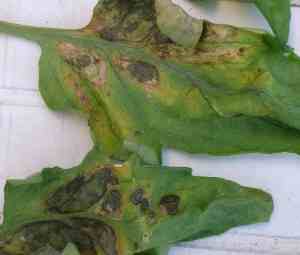Tomato Blight Treatment UK Update
Over the past few years, a number of chemical treatments for disease prevention have been withdrawn from sale, owing to EU rules and regulations.
Dithane 945 was the most effective blight protection that I used regularly, but is no longer available. Also, Bordeaux Mixture has been withdrawn from sale which also protected leaves against fungal infection. Systhane became the alternative for Dithane, but that too has now been withdrawn.
Although there is no cure for blight, these products offered some protection and helped to stop the problem getting worse.
There are anti-fungal sprays available but these are for non-edibles only.
Most of this article was written when the products mentioned above were still available, but I’ve kept the parts that are still useful in helping to avoid tomato blight.
I suggest that if you experience tomato blight regularly each season, grow blight-free tomato varieties such as Crimson Crush and Mountain Magic.
Signs of Blight
Tomato blight (also known as potato blight) is a fungal disease which is caused by wet, damp conditions and mainly affects tomato and potato plants growing outdoors.
Before beginning removing leaves etc., it is best to make sure that your plants have a fungal infection, so here’s the information you need below.
If it has been wet in your area for a prolonged period, and you are growing tomatoes outside, it is possible that your plants have blight.
There are two types of blight
Early Blight
shows itself as dark round spots surrounded by concentric rings that fade to yellow. Wet leaves combined with cold temperatures in the Spring will leave a plant susceptible to early blight.
Late Blight – the most common and devastating type!
Late blight starts as brown patches on the edges of leaves that spread to make darkened areas on the stem. Eventually the fungus will take over the entire plant – fruit too as in the photo left.
Damp Conditions
The combination of wet leaves and high humidity over a prolonged period is almost certain to cause tomato blight. As a fungal infection, it can easily spread from plant to plant and on fingers too, so it’s best not to touch plant leaves and run the risk of contaminating healthy plants.
Avoiding Blight
It is common to have a touch of fungal infection on one or two lower leaves when growing outdoors, especially if you live in an area that gets a lot of rain.
Remove the infected leaves and leaf branches, and keep the base of your plants free from decaying leaves. Good air circulation at soil level helps keep plants healthy.
However, greenhouses that are poorly aerated can also be a cause of blight because of high humidity and condensation.
The best way to avoid blight and fungal disease in the greenhouse is to open the windows during the day. Better still, use an electric fan heater to circulate the air – especially in the early mornings.
How To Prevent Tomato Blight
If growing outside provide some kind of shelter for your plants if possible. Wet leaves are ok for a few hours, but overnight in damp conditions followed by another wet day will lower the plants defences.
Ferline and Legend are supposed to be blight tolerant – that is they have a greater defense against blight than other varieties. The seasons 2008 to 2010 where very wet in my area and every variety that I grew, including Ferline, contracted blight.
More suggestions to follow
- Keep tomato leaves dry – provide some shelter from the rain if possible.
- Water in the morning to that plants are not stood in excess water overnight.
- Remove some of the lower leaves (by pulling off – not cutting) if they show signs of infection.
- Don’t touch leaves of plants and spread the disease on fingers.
Rain
I sometimes hear people say things like: “a drop of rain will do them good” and “when you water, water the leaves too” my advice is to keep those leaves dry. The only time I will allow my leaves to get wet is when I foliar feed, which I do on a dry day.
Rain water is good for tomato plants because it is usually slightly acidic in pH value, which is how tomato plants like their water and soil!
Anyone who grows tomatoes outdoors in the UK will have experience of blight. However, being aware of the problem is half the battle in preventing it.
Healthy Plants
One thing is sure, and that is: healthy plants have better resistance against disease than plants that are struggling.
An encouragement to keep our plants in top condition!
Blight Free Tomato Seeds
A very good way to avoid blight when growing tomatoes outside is to sow and grow a blight free tomato variety such as the Crimson Crush. It’s not just blight free, it is a medium to large tomato with a great taste and yield, perfect for outside in the garden or allotment. Crimson Crush seeds are available here.
See Also: Tomato Problems



